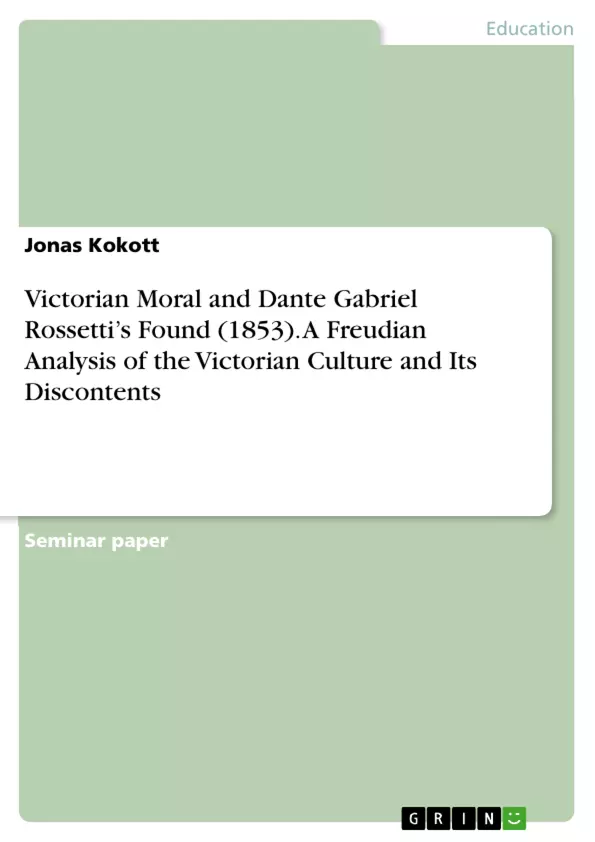The artistic emblazonment of female guilt makes for a compelling opportunity to provide a paper with a Freudian viewpoint on the Victorians moral and the “Fallen Woman”, an approach this paper sets out to follow through. During the analysis, wide-spread literature and artworks produced during the Victorian era will be consulted and, lastly, the notion of guilt is going to be elaborated and put into context on Dante Gabriel Rossetti’s Found (1853). Concerns about the modernizing world causing social turmoil was germane to Victorian belief.
In 1840, psychiatrist Forbes Winslow plainly declared that “insanity, in all its phases, marches side by side with civilisation” and while the unprecedented industrial revolution enabled prosperity and political power to a vastly expanding bourgeoise, the Victorian era must be also referred to as a precarious period of clashing social and sexual contrasts. While the middle-class helped to shape Victorian moral by cultivating ideas of a peaceful suburban home, self-discipline and chastely womanhood, Victorians constantly feared an imminent collapse of their society. Especially the overpopulated and dirty cities were viewed as potential breeding grounds for chaos due to increasing poverty and rising numbers of “Fallen Women”, most of them being prostitutes. Victorian artists produced a myriad of paintings that centred around the tragic fate of “Fallen Women” that were primarily depicted as guilt-ridden outcasts.
The representation of guilt as consequence of immoral behaviour seemed to be the artistic intersection of aforementioned colliding contrasts. Here, a bourgeoise audience was able to safely assure themselves of their own inviolable morals by ‘witnessing’ sinful female behaviour and the accompanying repercussions on canvas. From a psychoanalytical perspective, the notion of guilt that the Victorians were eager to a to the prostitute deserves attention. In Civilization and Its Discontents, Sigmund Freud argued that sense of guilt “is the most important problem in the evolution of culture ” and “that the price of progress in civilization is paid in forfeiting happiness through the heightening of the sense of guilt”.
Inhaltsverzeichnis (Table of Contents)
- Introduction
- Culture and Discontents
- Victorian Ideals and Victorian Fears
- The "Angel in the House" - The Female Ideal.
- The "Fallen Woman" - A Threat to Victorian Culture.
- The Repression of Female Sexuality.
- Psychoanalysis and the Victorians
- A Freudian Analysis of the Fallen Woman in Rossetti's Found
Zielsetzung und Themenschwerpunkte (Objectives and Key Themes)
This paper explores the Victorian era through a Freudian lens, focusing on the anxieties and contradictions surrounding the "Fallen Woman" and her representation in art. It analyzes the relationship between Victorian moral ideals and the repression of female sexuality, drawing on Sigmund Freud's theories of the unconscious, the id, the ego, and the super-ego. The paper argues that the depiction of guilt in Victorian art serves as a means to address the societal anxieties about the breakdown of traditional morals and the emergence of a modern, industrial society.
- Victorian Morality and its Relationship to Cultural Anxiety
- The "Fallen Woman" as a Symbol of Social and Sexual Disruption
- The Repression of Female Sexuality and its Impact on Victorian Society
- The Role of Guilt in Victorian Art and Culture
- A Freudian Analysis of Dante Gabriel Rossetti's "Found" (1853)
Zusammenfassung der Kapitel (Chapter Summaries)
The introduction sets the stage for the paper by introducing the context of the Victorian era as a time of social and sexual change, marked by the rise of the bourgeoisie and the fears of a collapsing society. It highlights the role of the "Fallen Woman" in Victorian art and foreshadows the application of Freudian theory to understand the Victorian moral landscape.
Chapter 2 delves deeper into Freud's concept of civilization and its discontents, arguing that culture serves to repress primal instincts, leading to a heightened sense of guilt. It explores the complexities of Victorian moral codes, noting the influence of the middle class and their use of "propaganda" to establish moral superiority.
Chapter 3 examines the key Victorian ideals and fears, focusing on the dichotomy between the "Angel in the House" and the "Fallen Woman." It sheds light on the Victorian concepts of health, psychology, and self-restraint, highlighting the influence of these ideals on social expectations and individual behavior.
Schlüsselwörter (Keywords)
The primary keywords and focus topics of this paper include Victorian morals, the "Fallen Woman," Freudian psychoanalysis, the unconscious, guilt, repression of female sexuality, art and culture, and Dante Gabriel Rossetti's "Found" (1853). The paper delves into the intersection of social, psychological, and artistic expressions within the Victorian era, using Freudian theory to illuminate the anxieties and contradictions of this historical period.
- Arbeit zitieren
- Jonas Kokott (Autor:in), 2021, Victorian Moral and Dante Gabriel Rossetti’s Found (1853). A Freudian Analysis of the Victorian Culture and Its Discontents, München, GRIN Verlag, https://www.grin.com/document/1150048




